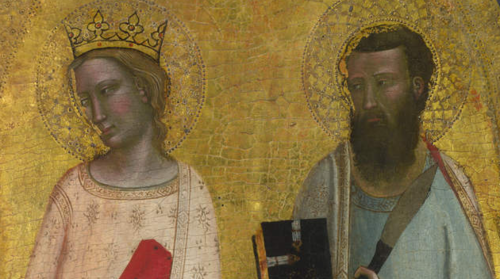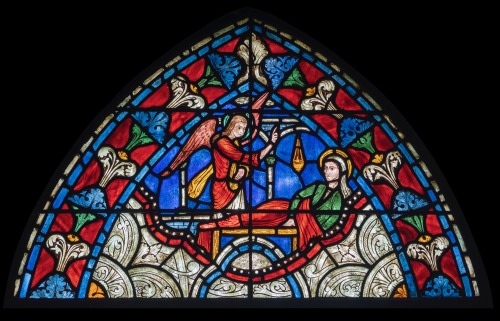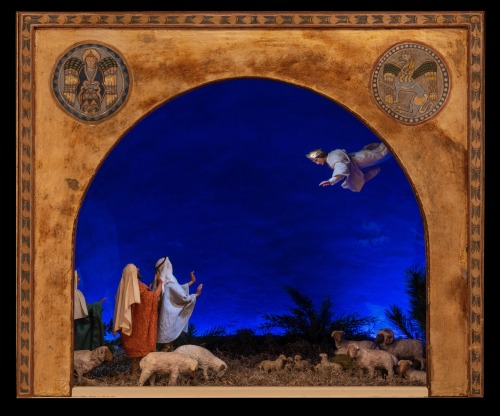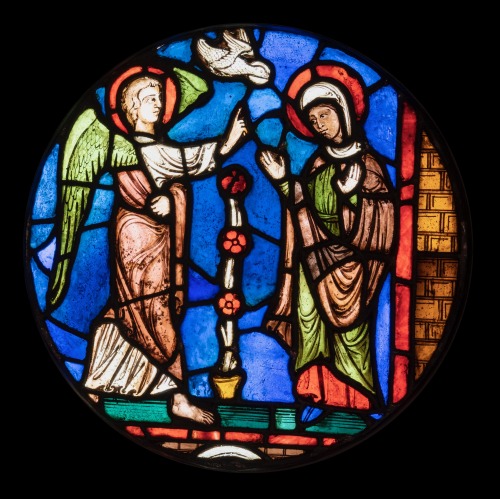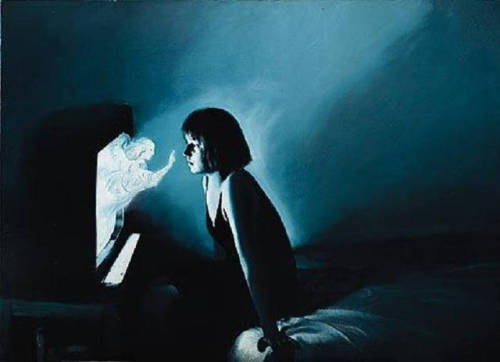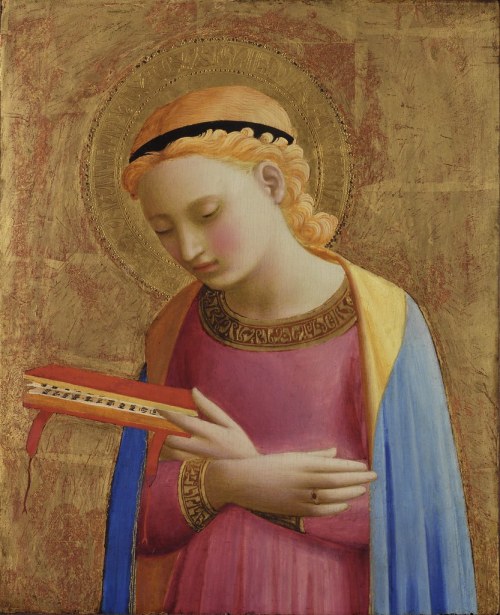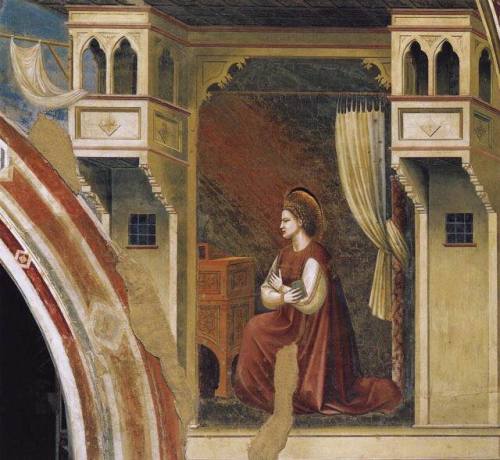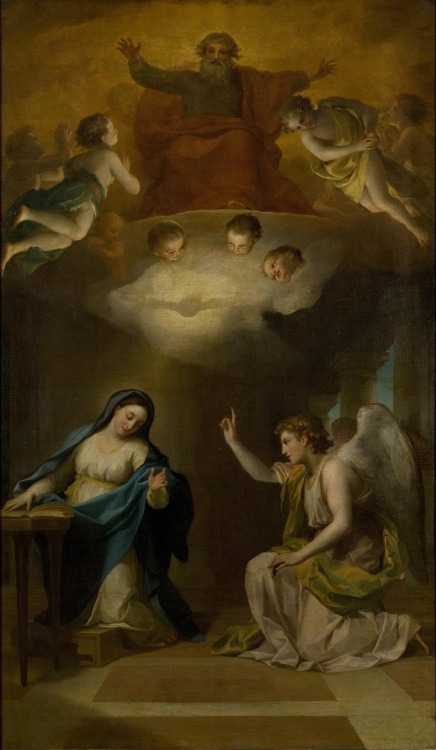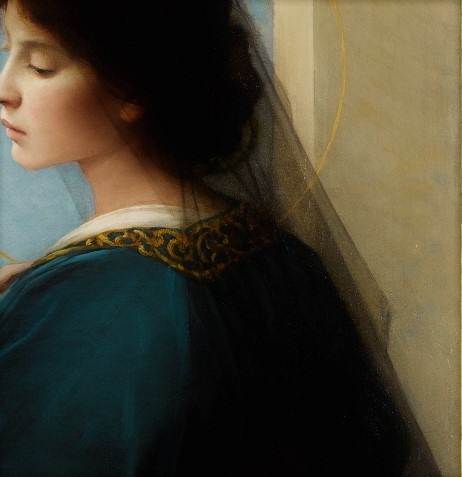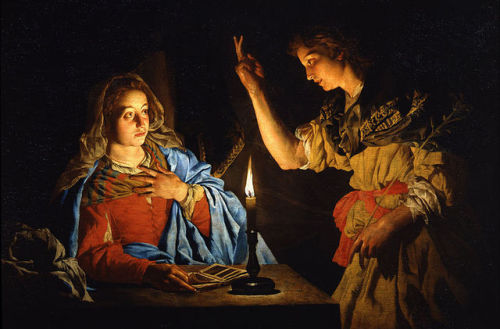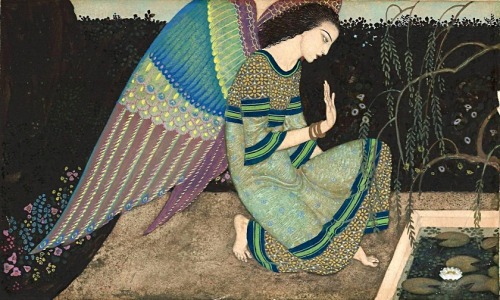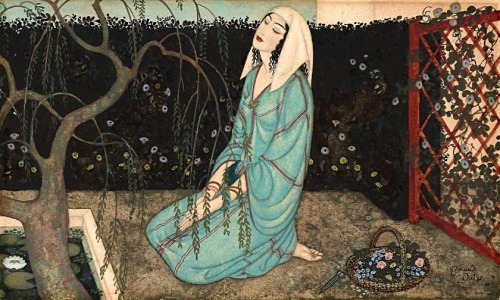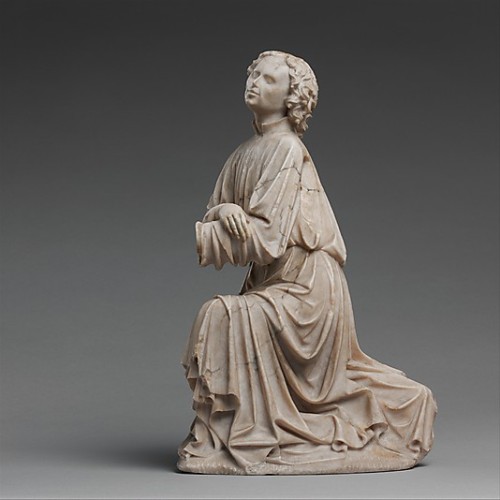#annunciation
I fukin love 14th century art art because everyone looks so shady and suspicious of ppl around them its AMAZING
or just like they know something u dont and oh my gdfuck i cant
I believe the highest point is reached in Simone Martini’s Annunciation
and the look of absolute hatred Mary and Gabriel exchange.
ADVENT CALENDAR DAY TWO
Stained-glass panel by Winfred S. Hyatt from the Christmas window in Glencairn’s Chapel in Bryn Athyn, PA. The window was made by Lawrence Saint and Winfred Hyatt from 1928 to 1956. Glencairn Museum, Bryn Athyn, PA.
This stained-glass panel, made in the Bryn Athyn glassworks, depicts the moment when the angel Gabriel announces to Mary, who is resting on a bed indoors, that she has been chosen to be the mother of Jesus Christ. According to the Gospel of Luke, the angel said, “Behold, you will conceive in your womb and bring forth a Son, and shall call His name Jesus” (1:31). The scene is at the top of the Christmas window on the south wall of Glencairn’s Chapel. While the lower scenes in this window were copied from the original 13th-century church of Sainte-Radegonde outside the city of Poitiers, France, this Annunciation seems to have been designed by Bryn Athyn artist Winfred S. Hyatt. (An Annunciation scene has not survived from the window at Sainte-Radegonde.)
Every day, from December 1 through December 25, a new work of Nativity art from the Glencairn Museum collection will appear on our website (Follow the Star: A 2021 Advent Calendar). To receive these in your newsfeed, follow the Museum’s social media (Facebook, Instagram, Twitter, Tumblr).
Post link
ADVENT CALENDAR DAY ONE
Fresco by an unknown artist from the Clarissan monastery of Santa Maria inter Angelos, near Spoleto, Italy (c. 1300). Glencairn Museum, Bryn Athyn, PA, 08.FS.07.
The story of the Annunciation to Mary comes from the Gospel of Luke (1:26–38), in which the angel Gabriel appears to Mary and informs her that she will give birth to Jesus, the Son of God. This large, 13th-century Italian fresco in Glencairn’s Great Hall depicts the moment when Gabriel delivers this astonishing news. The angel says to her, “Do not be afraid, Mary, for you have found favor with God. And behold, you will conceive in your womb and bring forth a Son, and shall call His name Jesus.” (Luke 1:30–31). Gabriel, on the right with wings and a halo, walks toward Mary with his hands in a gesture of blessing. Mary, also wearing a halo, inclines her head, which is covered with a cloak, to Gabriel.
Every day, from December 1 through December 25, a new work of Nativity art from the Glencairn Museum collection will appear on our website (Follow the Star: A 2021 Advent Calendar). To receive these in your newsfeed, follow the Museum’s social media (Facebook, Instagram, Twitter, Tumblr).
Post link
ADVENT CALENDAR DAY 18
Diorama of the Annunciation to the Shepherds by Winfred S. Hyatt, made around 1925. Glencairn Museum, Bryn Athyn, PA, C37.
This scene shows the Annunciation to the Shepherds (Luke 2:8–14), from the narrative of the Nativity of Jesus Christ. Here an angel in a white robe, and wearing a golden crown, descends from above, telling the shepherds that they will “find a babe wrapped in swaddling cloths and lying in a manger.“
Winfred S. Hyatt made three Nativity scenes for the Raymond and Mildred Pitcairn family during the 1920s; this scene is one of the three. Hyatt, the principal stained-glass artist and designer for Bryn Athyn Cathedral and later Glencairn, also made Nativity scenes for the Cathedral, the Harold Pitcairn family, and President and Mrs. Eisenhower. Hyatt modeled all the figures for the Pitcairn scenes, which were then cast in plaster, painted, and clothed.
Every day, from December 1 through December 25, a new work of Nativity art from the Glencairn Museum collection will appear on the home page of our Advent calendar (Follow the Star: A 2021 Advent Calendar). To receive these in your newsfeed, follow our social media (Facebook, Instagram, Twitter, Tumblr).
Post link
ADVENT CALENDAR DAY 14
Stained-glass panel depicting the Annunciation to Mary made in 13th century France. Glencairn Museum, Bryn Athyn, PA, 03.SG.236.
This stained-glass panel, made in 13th-century France, recounts the moment when Mary was told by the angel Gabriel that she has been chosen to be the mother of Jesus Christ. According to the Gospel of Luke, the angel said, “Behold, you will conceive in your womb and bring forth a Son, and shall call His name Jesus” (1:31).
On the left, the winged angel Gabriel walks toward Mary with his hand raised in greeting. Mary stands before Gabriel with the palms of her hands facing outward. This gesture signals Mary’s acceptance of what she is being told and her willingness to receive the Holy Spirit (represented by the dove flying toward her). The two figures are separated by a vase with a tall spray of roses, a flower closely associated with Mary.
Every day, from December 1 through December 25, a new work of Nativity art from the Glencairn Museum collection will appear on the home page of our Advent calendar (Follow the Star: A 2021 Advent Calendar). To receive these in your newsfeed, follow our social media (Facebook, Instagram, Twitter, Tumblr).
Post link
ADVENT CALENDAR DAY 6
Stained-glass roundel of the Annunciation to the Shepherds made in 13th-century France. Glencairn Museum, Bryn Athyn, PA, 03.SG.240.
This 13th-century stained-glass roundel illustrates the biblical story of the Annunciation to the Shepherds (Luke 2:8–14). Here an angel with green wings and a purple cloak descends from a heavenly cloud, announcing to the shepherds that they will “find a babe wrapped in swaddling cloths and lying in a manger.”
According to Professor Michael W. Cothren, “Medieval artists commonly used a wavy, arching band of clouds (frequently placed across the corner of a rectangular composition) to show a separation between the earthly realm below and the heavenly realm above. For example, when a disembodied hand of God emerges from heaven to command or bless a situation taking place on earth, it is often overlapped by an arching band of ‘clouds of heaven.’ Sometimes the face of God appears within the cloud band. Sometimes angels swoop down toward earth underneath or emerging from the clouds.” (“The ‘Clouds of Heaven’ Motif in Art Created for Glencairn,” Glencairn Museum News No. 1, 2021).
Every day, from December 1 through December 25, a new work of Nativity art from the Glencairn Museum collection will appear on the home page of our Advent calendar (Follow the Star: A 2021 Advent Calendar). To receive these in your newsfeed, follow our social media (Facebook, Instagram, Twitter, Tumblr).
Post link
“We do not need a truth to serve us; we need a truth that we can serve.”
~ Jacques Maritain
[Annunciation (detail), 1440 - 1442 - Fra Angelico]
• Jacques Maritain (1882–1973), French philosopher and political thinker, was one of the principal exponents of Thomism in the twentieth century and an influential interpreter of the thought of St Thomas Aquinas. More: https://plato.stanford.edu/entries/maritain/
• Over the course of roughly 15 years, Angelico completed several renditions of the Annunciation, an ethereal event that remains at the core of certain Christian teachings. Rendered as spirited panel paintings, shimmering altarpieces, and vibrant frescoes, Angelico’s Annunciations seem to float above other artists’ interpretations. More: https://mymodernmet.com/fra-angelico-the-annunciation/
Post link
“A state of inner readiness and waiting. I’m open to all annunciations.”
~ Anna Kamieńska
[Annunciation, by Giotto]
• During the Nazi occupation of Poland, Anna Kamieńska (1920–1986) taught at various underground schools in and around Lublin, where she spent her formative years. After graduating from college, she studied Classical Philology at the University of Łódź and went on to marry the poet Jan Śpiewak in 1948. The two collaborated on translations of Russian poetry and drama until Śpiewak’s sudden death from cancer in 1967. More: https://www.the-tls.co.uk/articles/poem-week-thanking/
• An artist who played a decisive role in the development of Italian painting in his century and beyond… His earliest works, such as the painted crucifix in Santa Maria Novella and the Maestà formerly in San Giorgio alla Costa and now in the Museo Diocesano, both in Florence, and especially his biblical frescoes in the upper church of the basilica of San Francesco at Assisi, reveal the strong influence of the Roman school, both contemporary and classical.
Post link
HOMILY for The Annunciation of the Lord
Isa 7:10-14. 8:10; Ps 29; Heb 10:4-10; Luke 1:26-38

The renewal of the whole cosmos pivots on this moment, on the Fiat, the humble and trusting assent of Mary to God’s plan of salvation. As soon as Mary says ‘yes’, the eternal Word of God takes flesh in her womb; the Son of God unites himself to our humanity, and so human nature is elevated to divine heights; and God enters human history and place, coming alongside us in all our human joys and sorrows, sharing the pleasure and the pain of our humanity. Thus Scripture says: “You who wanted no sacrifice or oblation, prepared a body for me”. Because of Christ’s Incarnation, the human body is now the locus of salvation; the place wherein the struggle against sin and temptation, and the offering of the human person to God takes place. Hence, Hebrews also says that God willed that we are made holy “by the offering of his body made once and for all by Jesus Christ.”
Through the grace of Christ, Mary too, from the moment of her immaculate conception, offers herself, body and soul, to God. Mary is made holy through her fiat, the gift of herself to God, such that she is ever obedient to his Word, ever open in faith to God’s will. Thus, when the angel announces that she will conceive miraculously by the power of the Holy Spirit, she says ‘yes’, and so she, the All-Holy Virgin offers her body, her virginal womb, to become the sinless dwelling place of God the Son. In her own body, then, Mary becomes the locus of salvation, as she becomes the new Ark of the Covenant, the Bearer of God to all peoples.
As the body, the whole person of Mary is open to God’s Word, so we say that her heart, the immaculate heart of Mary, is ever open to God’s will, always at the service of God who is Love. Hence Pope Benedict XVI said, “The Heart open to God, purified by contemplation of God, is stronger than guns and weapons of every kind. The fiat of Mary, the word of her heart, has changed the history of the world, because it brought the Saviour into the world - because, thanks to her Yes, God could become man in our world and remains so for all time.”
Yes, the history of the world, has been changed from the moment of the Annunciation onwards. And, indeed, the whole of creation which had been at war and enmity with God has been reconciled to God, and so peace is restored between God and Man because of the Incarnation, because of the assent of the Immaculate Heart of Mary to God’s peace plan. As such, in every age, peace is promised us if we will turn to God once more, if we will consecrate ourselves and our world to Mary’s Immaculate Heart, which means that we seek, by the power of God’s grace and the intercession of Mary, to become totally open to God’s will, totally obedient to his Word, totally offered up to his service.
Pope Benedict thus taught that “since God himself took a human heart and has thus steered human freedom towards what is good, the freedom to choose evil no longer has the last word. From that time forth, the word that prevails is this: ‘In the world you will have tribulation, but take heart; I have overcome the world’ (Jn 16:33). The message of Fatima invites us to trust in this promise.”
Today, in consecrating the world and particularly Russia and Ukraine to the Immaculate Heart of Mary, therefore, Pope Francis and the world’s bishops in communion with him, and all of us as faithful Catholics, are putting our trust in God’s promise, a promise brought into focus anew by Our Lady of the Rosary at Fatima. This is the promise that by the grace of Christ, the Risen Lord who has conquered sin, suffering, and death, shall so convert souls that God’s Word of peace, God’s Word of Love, will reign in our hearts and move us to freely choose that which is good.
So Pope Francis said “Let us prepare ourselves to live a day of prayer on the Solemnity of the Annunciation, asking the Mother of God to lift up the hearts of those who are afflicted by the cruelty of war. May the Act of Consecration to her Immaculate Heart bring peace to the world.” This is our prayer today, and this is our belief, that in God’s will, in doing his will, we shall truly find peace. So Scripture says: “Here I am, Lord! I come to do your will.” Or as Mary says: “Let it be done to me according to your Word.”
Whenever we unite ourself to these words of Mary, and we offer ourselves, our bodies, our whole hearts to God and his will, then our world is renewed, and we are lifted up closer to God. This is what consecration to God through Mary entails; this is what we do today, choosing to walk in God’s ways of love, trusting that, as the angel Gabriel prophesied, Jesus’s “reign will have no end” for his is a reign of truth and life, a kingship of holiness and grace, a kingdom of justice, love, and peace.
HOMILY for Our Lady of Loreto
Isa 48:17-19; Ps 1; Mt 11:16-19

“Drop down dew from above, you heavens”. For many, these words from Isaiah, Rorate caeli desuper, which began our Entrance antiphon tonight, are one of the key phrases of the Advent season. In the Second Eucharistic Prayer we say: “Make holy, therefore, these gifts, we pray, by sending down your Spirit upon them like the dewfall”, and so the dew that is mentioned by Isaiah is likewise a reference to the descent of the Holy Spirit, to God’s grace falling from the heavens to soften the hardness of our hearts, and to bring refreshment and joy to our lives, just as dew upon the grass softens the cold earth and glitters beautifully in the morning sunlight.
Isaiah goes on: Having called down the Holy Spirit to descend like dew from the heavens, he says, “let the clouds rain down the Just One; let the earth be opened and bring forth a Saviour.” So, in the Holy Mass the Holy Spirit descends on the bread and wine, the fruit of the earth, and these become the Body and Blood of Christ the Saviour. The earth, therefore, is opened and brings forth a Saviour.
However, these words of the prophet aren’t principally about the Mass, but rather, first of all, about the Incarnation of Christ. By the power of the Holy Spirit coming down from heaven, God’s grace which is unseen but vivifying like the dew, saturates the earth of the Virgin Mary’s and makes her fruitful, so that her womb opens and brings forth the Saviour, Jesus Christ. People sometimes think that Christmas is the feast of the Incarnation, but of course this isn’t quite accurate. The Incarnation, the moment when Mary conceives by the overshadowing of the Holy Spirit, is more properly celebrated liturgically on the 25th of March. We tend to call that date the feast of the Annunciation but it can more accurately be called the feast of the Incarnation, and each time we pray the Angelus (as we do every evening before this Mass) we recall the moment of the Incarnation when “the Word became flesh and dwelt among us”.
But where did the Incarnation take place? Most people will say, in accordance with Scripture, in Nazareth, and indeed if we go to Nazareth we will find a great church built around the site of Mary’s house, the place where the Annunciation happened, along with a marble slab incised with these words: “Here the Word became flesh.” However, when I visited Nazareth, I was disappointed to find that only the foundations of this house and a few stones remained there. Likewise in 1061, following a vision, Richeldis had a copy of the Holy House of Nazareth built in Walsingham. But even there, nothing remains but the foundations. Where did the Holy House go? In the 13th-century, a noble family of Crusaders called the Angel family had the Holy House moved, stone by stone, to Italy for safekeeping. Because at that time the Holy Land was being conquered by Muslim armies who had been destroying the Christian shrines.
Today’s feast, therefore, which was extended to the whole Church by Pope Francis, is a commemoration of the Holy House of Mary which is now enshrined in Loreto, Italy. However, as the Collect of the Mass makes clear, we’re not commemorating a building but the great response of Mary who lived in that house: her humility was pleasing to God and her obedience was profitable for us, for it gained for us the Saviour. Indeed, through her Fiat, Mary herself became the Holy House within whom God dwelt for nine months. It is the manifestation of the Incarnate Word to the whole world, his birth and his glorious epiphanies that we will celebrate at Christmastide.
However, the greatest marvel of all is that this same Word becomes flesh here as well. For this same Saviour wills to become our food and drink in the Mass as, by the action of the same Holy Spirit descending upon the bread and wine on the altar, Christ becomes present – body, blood, soul, and divinity – in the Sacrament of the Eucharist, given to us so that we might each be opened to receive the Just One, the Saviour, God-with-us. Let us have the humility of Mary and follow her obedience to the Word so that God’s grace will open us up to become fruitful in works of goodness and justice and truth. Thus shall we Christians also be said to bring forth the Just One for our world today that stands ever more in need of his salvation.
Anton Raphael Mengs (Aussig, Bohemia 1728 - 1779 Rome), The Annunciation, 1776-1779, oil on canvas, 388 x 222 cm. The Hermitage Museum
Post link
The love that Angels create in our hearts
“When angels visit us, we do not hear the rustle of wings, nor feel the feathery touch of the breast of a dove; but we know their presence by the love they create in our hearts”
The text below is the excerpt of the book Angels (ASIN: B00IODLIWE), written by Clara Erskine Clement, published by Parkstone…


Annunciation
An alabaster statue of a kneeling angel, from c. 1430-40. The statue was made in Burgundy and stands at only 14.5 inches high. The angel was originally part of a collection made by a group of anonymous sculptors that depicted either the Annunciation or Christ as the Man of Sorrows.
Post link

